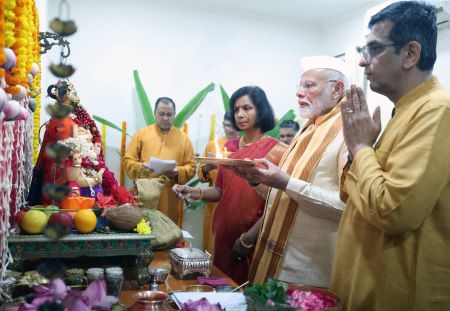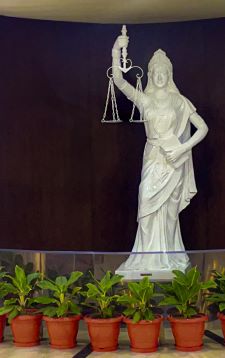Justice DY Chandrachud’s tenure as CJI balanced ideals with compromises, fuelling debate over judicial independence
IN THE CARAVAN’s November 2024 cover story, investigative journalist Saurav Das presents a nuanced examination of Chief Justice of India DY Chandrachud, capturing his evolution from an initially celebrated reformist to a figure often seen as navigating cautiously through India’s politically charged judiciary.

In his feature, “Performative Justice: The Equivocations of DY Chandrachud” Das paints a portrait of a CJI caught between upholding constitutional ideals and managing pressures from the political executive.
Chandrachud’s tenure, beginning on November 9, 2022, raised high expectations. With his reputation as a “rockstar judge” known for progressive stances, many observers hoped he would reassert judicial independence amid rising political interference. However, as Das’s article reveals, Chandrachud’s tenure has been marked by decisions that reflect both intellectual rigor and an apparent aversion to direct confrontation with the Modi government.
A Balancing Act: Judicial Independence and Political Concessions
Das highlights a few critical instances where Chandrachud’s actions seemed to waver between judicial ideals and political pragmatism.
A key example occurred in September 2024, when Chandrachud performed an aarti with Prime Minister Narendra Modi at the CJI’s residence during the Ganesh festival. Critics saw this as blurring the line between the judiciary and the executive, particularly with state elections nearing in Maharashtra.

PM Narendra Modi Visits CJI DY Chandrachud’s Residence For Ganesh Puja
Das underscores how Chandrachud’s assignment of sensitive cases within the Supreme Court has also raised questions. Often, politically charged cases have been assigned to junior judges perceived as sympathetic to the ruling government.
Das’s feature notes that this has led to judgments in favour of the Modi administration in cases concerning opposition leaders and other politically sensitive matters.
This pattern, according to Das, might reflect a broader strategy to avoid direct confrontations with the executive branch. Given the CJI’s significant influence over the judiciary, such moves could impact public confidence in the independence of India’s highest court.
Revisiting Landmark Judgments: A Mixed Legacy
Chandrachud’s role in key rulings, such as the 2019 Ayodhya judgment and the ongoing Gyanvapi mosque dispute, are also under scrutiny.
 Das points out that the 2019 judgment, which awarded the disputed land in Ayodhya to Hindu claimants, raised concerns that the judiciary might be yielding to a majoritarian agenda.
Das points out that the 2019 judgment, which awarded the disputed land in Ayodhya to Hindu claimants, raised concerns that the judiciary might be yielding to a majoritarian agenda.
Additionally, Chandrachud’s judgments in cases involving Maharashtra’s political crisis appeared to favor the BJP, leading some to question the judiciary’s autonomy from executive influence.
Legacy of Roster Management and Collegium Compromises
Das delves into Chandrachud’s controversial management of the court’s master roster, particularly his assignments of sensitive cases to judges perceived as having pro-government leanings. This choice, as well as his willingness to accommodate government-preferred appointments to judicial positions, has sparked criticism.
In one instance, Chandrachud reportedly agreed to several transfers and appointments that aligned with the executive’s interests, decisions that raised concerns among senior judges who perceived these choices as eroding the judiciary’s independence.
 These instances, Das notes, add to a broader picture of Chandrachud as a “jurist judge” – an intellectual who seeks judicial restraint rather than confrontation.
These instances, Das notes, add to a broader picture of Chandrachud as a “jurist judge” – an intellectual who seeks judicial restraint rather than confrontation.
While Chandrachud has emphasized transparency and procedural reforms, such as digitizing court processes and live-streaming hearings, his reluctance to resist government preferences in judicial appointments has led some to describe his tenure as “two steps forward, four steps backward, six steps sideways.”
The Dilemma of Performative Justice
Das’s article reflects on the personal and professional journey of Chandrachud, noting how his storied legacy as the son of former Chief Justice YV Chandrachud shaped his view of judicial restraint.
While his intellectual prowess and liberal credentials remain admired, Das argues that his cautious approach in politically sensitive cases reflects a pattern of “performative justice”—where judicial ideals are espoused in theory but softened in practice.

As Chandrachud’s tenure as CJI comes to an end on Sunday, November 10, 2024, Das raises the question of whether his leadership fulfilled the initial promise of a judiciary firmly independent of political interference or if his legacy will be marked by concessions to executive power.
Das concludes that Chandrachud’s legacy will likely be remembered less for his lofty ideals and more for the troubling precedents he set during a time marked by the judiciary’s quiet submission to executive power.
Whether it was cases being assigned to benches that consistently favoured the government, the weakening of the collegium’s resistance to political influence, or judgments that subtly opened doors for the executive, a look at Chandrachud’s tenure reveals a judiciary retreating from its role as a check on power, while the CJI publicly maintained a progressive image.

Lady Justice
“Chandrachud is ‘suffering from delusions of grandeur,’” Dave said in an interview. He argued that, in both the Ganesh Puja with Modi and the statement about asking God for a solution in the Ram Janmabhoomi case, he knew exactly what he was doing. “Perhaps these two statements were made with some kind of future reward in mind, some kind of quid pro quo,” he said. “Because he is trying to tell those in power, after all, I am a proud Hindu.”
Also Read: A Legacy Best Forgotten
“Before he became Chief Justice, he often used to say, ‘Independence of the judiciary means you must speak truth to power.’ But he doesn’t say that anymore,” Colin Gonsalves observed. “He knows people understand that he was unable to speak truth to power.” Like the new Lady Justice statue, Chandrachud has likely done this with his eyes open. ![]()
Disclaimer : PunjabTodayNews.com and other platforms of the Punjab Today group strive to include views and opinions from across the entire spectrum, but by no means do we agree with everything we publish. Our efforts and editorial choices consistently underscore our authors’ right to the freedom of speech. However, it should be clear to all readers that individual authors are responsible for the information, ideas or opinions in their articles, and very often, these do not reflect the views of PunjabTodayNews.com or other platforms of the group. Punjab Today does not assume any responsibility or liability for the views of authors whose work appears here.
Punjab Today believes in serious, engaging, narrative journalism at a time when mainstream media houses seem to have given up on long-form writing and news television has blurred or altogether erased the lines between news and slapstick entertainment. We at Punjab Today believe that readers such as yourself appreciate cerebral journalism, and would like you to hold us against the best international industry standards. Brickbats are welcome even more than bouquets, though an occasional pat on the back is always encouraging. Good journalism can be a lifeline in these uncertain times worldwide. You can support us in myriad ways. To begin with, by spreading word about us and forwarding this reportage. Stay engaged.
— Team PT
